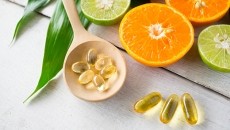Seaweed contains natural antibiotic
pathogens with naturally occurring antibiotics, which could present
oppportunities for future nutraceuticals, report US researchers.
Seaweed species have been found to defend themselves from specific pathogens with naturally occurring antibiotics, which could present oppportunities for future nutraceuticals, report US researchers.
Scientists at the Georgia Institute of Technology in Atlanta isolated a potent antifungal compound contained in the common seaweed species Lobophora variegat. They say the finding helps explain why some seaweeds, sponges and corals appear to avoid most infections by fungi and bacteria.
"Seaweeds live in constant contact with potentially dangerous microbes, and they have apparently evolved a chemical defense to help resist disease," said lead author Julia Kubanek, an assistant professor of biology and chemistry at the Institute.
Few studies have addressed disease resistance in seaweeds, and seaweed diseases are little understood, except for species that are commercially important, such as the seaweed used for sushi, write the team in the 19 May issue of the Proceedings of the National Academy of Sciences .
"Based on the antimicrobial activities we detected in a large survey of many different algal species, it is possible that antimicrobial chemical defenses are more common than previously believed and that L. variegata may be one of many species that use natural antibiotics to defend against infection," said co-author Paul Jensen.
Jensen devised a bioassay to measure the antimicrobial potential of the common seaweed species Lobophora variegata. He combined biological extracts from seaweed harvested in the Bahamas with a fungus or bacterium and monitored the sample to see if the microbes grew. Of the 51 samples tested, 46 exhibited extraordinarily potent antifungal activity that could be traced to exceedingly low concentrations of an antifungal compound in the seaweed. Suppressed growth of microbes in the samples suggests that a natural antimicrobial compound is at work, Kubanek explained.
"We have discovered a new antibiotic with a complex chemical structure that structurally resembles two groups of macrolide antibiotics (those that kill fungi) - one found in marine sponges and the other in blue-green algae," Kubanek said.
Because of the tiny available quantities of this new compound, researchers have not applied for a patent yet. And scientists still need to determine whether the seaweed is actually the original source of the antibiotic, Kubanek added. The antimicrobial compound could be the byproduct of symbiosis between the seaweed and an as-yet unidentified microbe. If this is the case, it would be one of the rare examples of such a chemical defense for plants and animals, he explained.
The researchers believe that further investigations of chemically mediated interactions between marine microbes and larger organisms are likely to reveal new molecules and mechanisms that enable marine plants and animals to persist despite intense microbial challenges.
"Ecologically driven studies, such as this one, which used marine fungi in operationally simple assays, may be a promising strategy for uncovering novel natural products of commercial interest," concluded the authors.











